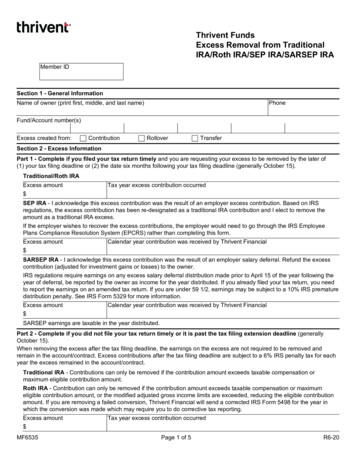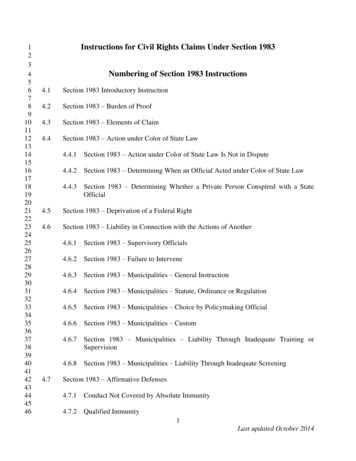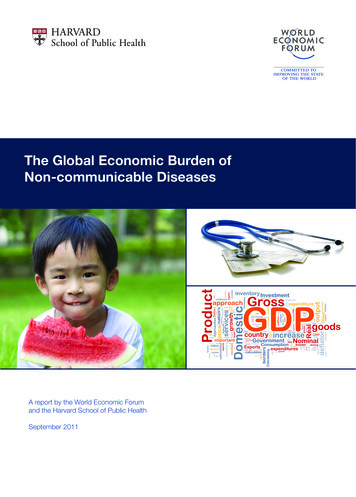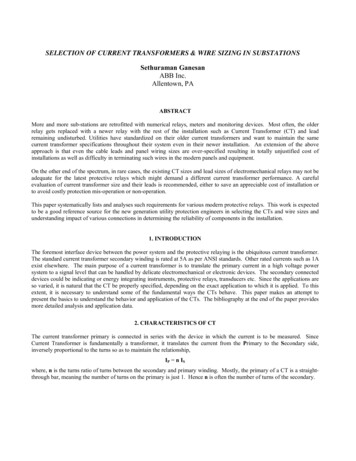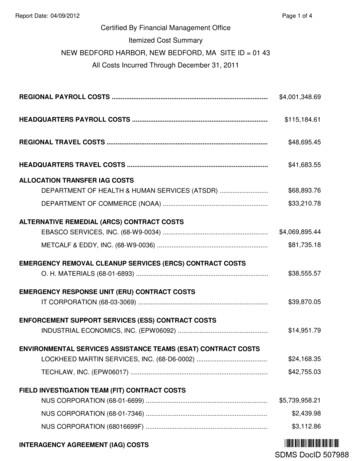
Transcription
Excess Administrative CostsBurden the U.S. Health Care SystemBy Emily Gee and Topher SpiroApril 8, 2019Anyone interacting with the U.S. health care system is bound to encounter examplesof unnecessary administrative complexity—from filling out duplicative intake formsto transferring medical records between providers to sorting out insurance bills. Thisadministrative complexity, with its associated high costs, is often cited as one reasonthe United States spends double the amount per capita on health care comparedwith other high-income countries even though utilization rates are similar.1Each year, health care payers and providers in the United States spend about 496 billion on billing and insurance-related (BIR) costs, according to Center forAmerican Progress estimates presented in this issue brief. As health care costs continue to rise, a logical starting point for potential savings is addressing waste. A 2010report by the National Academy of Medicine (NAM) estimated that the UnitedStates spends about twice as much as necessary on BIR costs.2 That administrativeexcess currently amounts to 248 billion annually, according to CAP’s calculations.This issue brief provides an overview of administrative expenditures in the U.S.health care system. It first explains the components of administrative costs and thenpresents estimates of the administrative costs borne by payers and providers. Finally,the issue brief describes how the United States can lower administrative coststhrough comprehensive reforms and incremental changes to its health care system.Many of the universal health care plans being discussed to expand coverage andlower costs would lower administrative costs through rate regulation, global budgeting, or simplifying the number of payers.3 Each of these financing changes deservesconsideration—even in the absence of major systemwide reform.Components of administrative costsThe main components of administrative costs in the U.S. health care system includeBIR costs and hospital or physician practice administration.4 The first category, BIRcosts, is part of the administrative overhead that is baked into consumers’ insurance premiums and providers’ reimbursements. It includes the overhead costs forthe health insurance industry and providers’ costs for claims submission, claims1Center for American Progress Excess Administrative Cost Burden the U.S. Health Care System
reconciliation, and payment processing. The health care system also requires administration beyond BIR activities, including medical record-keeping; hospital management; initiatives that monitor and improve care quality; and programs to combatfraud and abuse.To date, few studies have estimated the systemwide cost of health care administration extending beyond BIR activities. In a 2003 article in The New England Journal ofMedicine, researchers Steffie Woolhandler, Terry Campbell, and David Himmelsteinconcluded that overall administrative costs in 1999 amounted to 31 percent oftotal health care expenditures or 294 billion5—roughly 569 billion today whenadjusted for medical care inflation.6 A more recent paper by Woolhandler andHimmelstein, which looked at 2017 spending levels, placed the total cost of administration at 1.1 trillion.7Billing and insurance-related costsMany studies of administrative costs limit their scope to BIR costs. The BIR component of administration is most relevant to systemwide reforms that seek to reducethe expenses related to claims processing, billing rates, or health insurance. The largest share of BIR costs is attributable to insurance companies’ profits and overheadand to providers8 where BIR costs include tasks such as record-keeping for claimssubmission and billing.The costs associated with BIR administration can extend beyond the chief parties involved in receiving and submitting claims. The process of claims denials hasbecome an industry unto itself, with private firms squeezing dollars out of Medicaidprograms.9 One study estimated that the aggregate value of challenged claims rangesfrom 11 billion to 54 billion annually.10 Claims can also be manipulated to boostproviders’ or insurers’ profits by recording services rendered in maximum detail andexaggerating the severity of patients’ conditions—a practice known as upcoding.11Upcoding costs Medicare Advantage billions of dollars in excess expenditures,12 andin many cases the practice constitutes fraud.13The NAM published one of the most thorough reports on U.S. administrative costsrelated to billing and insurance in 2010. In a synthesis of the literature on administrative costs, the NAM report concluded that BIR costs totaled 361 billion in2009—about 466 billion in current dollars—among private insurers, public programs, and providers, amounting to 14.4 percent of U.S. health care spending at thetime. The NAM estimated that BIR costs account for 13 percent of physician carespending; 8.5 percent of hospital care spending; 10 percent of spending on otherproviders; 12.3 percent of spending on private insurance; and 3.5 percent of publicprogram spending, including Medicare and Medicaid.142Center for American Progress Excess Administrative Cost Burden the U.S. Health Care System
Applying the NAM’s percentages of BIR costs to recent projections of nationalhealth expenditures from the Centers for Medicare and Medicaid Services (CMS),CAP estimates that BIR costs will amount to 496 billion for 2019.15 (see Table 1)According to CAP’s calculations, this includes 158 billion in overhead for privateinsurance; 56 billion for administration of public insurance programs; and 282billion for the BIR costs of hospitals, physicians, and other care providers. CAP’sestimate does not include the administrative costs associated with retail sales ofmedical products, including prescription drugs and durable medical equipment.TABLE 1Administrative costs in the U.S. health care systemEstimated costs related to billing and insurance, 2019CategoryAnnual cost in billionsProviders (physicians, hospitals, and others) 282Private insurers 158Public programs 56Total 496Source: Authors’ calculations based on National Academy of Medicine, “Excess Administrative Costs,” inPierre Yong, ed., The Healthcare Imperative: Lowering Costs and Improving Outcomes: Workshop Series Summary(Washington: National Academies Press, 2011); Centers for Medicare and Medicaid Services, “National HealthExpenditure Data,” available at expenddata/nhe-fact-sheet.html (last accessed January 2019).Even the most inclusive studies of administrative costs have not included at leastone key piece of the U.S. health care system, namely, patients.16 The administrativecomplexity of the U.S. system also burdens patients, whether they are decipheringbewildering bills or shuttling records between providers. Three-quarters of consumersreport being confused by medical bills and explanations of benefits.17 A Kaiser FamilyFoundation survey of people newly enrolled in the health insurance marketplacefound that many were not confident in their understanding of the definitions of basicterms and concepts such as “premium,” “deductible,” or “provider network.”18 Insurersand employers spend an estimated 4.8 billion annually to assist consumers with lowhealth insurance literacy, according to the consulting firm Accenture.19Excess administrative costsWhile U.S. administrative care spending is indisputably higher than that of othercomparable countries, it’s unclear how much of the difference is excess and how muchof that excess could be trimmed. The NAM report estimated that excess BIR costsamount to 190 billion— 245 billion in current dollars—or roughly half of total BIRexpenditures in a year.20 The NAM report estimated that 66 percent of BIR costs forprivate insurers and 50 percent of BIR costs among providers are excess.21 Based onthese percentages, 248 billion of the total 496 billion BIR costs in CAP’s updatedestimate are excess administrative costs.3Center for American Progress Excess Administrative Cost Burden the U.S. Health Care System
Most studies that have attempted to identify excess costs in the American health caresystem rely on comparisons between the United States and Canada.22 In their 2010review of the literature on the difference between the two countries’ health expenditures, economists Alexis Pozen and David M. Cutler looked at the sources of the gapbetween U.S. and Canadian health spending. They found that 62 percent of the difference between the two countries was attributable to prices and intensity of care, and38 percent was linked to administrative costs.23 Compared with Canada, the UnitedStates has 44 percent more administrative staff, and U.S. physicians dedicate about50 percent more time on administrative tasks.24 Inflated to current dollars and today’spopulation, Pozen and Cutler’s estimate of per capita administrative excess in theUnited States, when compared with Canada, translates into a gap of 340 billion.25Woolhandler and Himmelstein estimate that the United States currently spends 1.1trillion on health care administration, and of that amount, 504 billion is excess.26Woolhandler and Himmelstein rely on surveys of physicians’ time use and utilizedphysician income data to translate the share of time physicians spend on administrative tasks into monetary value; their estimate of excess costs is the difference betweenU.S. and Canadian administrative spending.27 Woolhandler and Himmelstein’s original2003 article estimated that Canada spent 307 per capita on health system administration, compared with 1,059 per capita in the United States. Assuming this difference isexcess requires an assumption that a Canadian-style health care system would achievean identical level of administrative costs in the United States.A separate criticism of the original 2003 Woolhandler and Himmelstein estimates,as articulated by Henry J. Aaron, an economist at the Brookings Institution, is thattheir methodology failed to account for differences in prices.28 Woolhandler andHimmelstein arrive at their national total administrative costs by tallying up costs ineach country for items such as rent and salaries. As a consequence, the U.S.-Canadacomparison captures not just the differences in the quantity of resources devoted toadministration—such as physician time or office space—but also the differences inoffice rates, wages, and salaries. Taking Woolhandler and Himmelstein’s estimate oftotal administrative costs as a given and then making standard adjustments for pricedifferences, Aaron argues that the two researchers exaggerated U.S. administrativespending in their 2003 report and that the true portion of excess would be about onequarter less than what they estimated.All estimates of administrative costs are inherently sensitive to what portion of healthcare spending one considers administrative.29 For example, time spent recordingdiagnosis or prescription information used in billing may also be vital for patient care,allowing medical teams to share up-to-date information or avoid harmful drug interactions. A recent study of an electronic health records (EHR) system estimated that onaverage, half of a primary care physician’s day is spent on EHR interaction, includingbilling, coding, ordering, and communication.30 Such tasks, however, can fall into a grayarea between administrative and clinical. In a separate study, economist Julie Sakowski4Center for American Progress Excess Administrative Cost Burden the U.S. Health Care System
and her fellow researchers reported finding varying attitudes among physicians aboutwhether interaction with electronic medical records—a subset of EHR—representedadministrative or clinical time. As Sakowski and co-authors wrote, “Some felt they spentextra effort adding documentation that was needed only for billing. Others seemed tofeel that nearly all of that information was needed for accurate clinical records.”31Administrative costs for payersWithin the U.S. system, the share of expenditures that are attributable to administrative costs varies greatly by payer. The BIR costs for traditional Medicare and Medicaidhover around 2 percent to 5 percent, while those for private insurance is about 17percent.32 Some public finance experts, including Robert Book, have argued that thelow levels of Medicare overhead are deceptive. Because seniors have relatively highhealth expenditures, the argument goes, administrative costs make up a relatively smallshare of their total health care spending. However, Medicare’s per capita administrativeexpenditures are higher than those in other forms of insurance.33 Even if one compareshigher-end estimates of Medicare administrative costs to low-end estimates of costs forprivate insurance, the gulf between administrative costs for Medicare and private coverage is large.34 Organisation for Economic Co-operation and Development (OECD)data also show that other nations are able to achieve low levels of administrative costswhile maintaining universal coverage across all ages of the population.35International health system data demonstrate that the United States is a clear outlieron administrative spending. And while the OECD’s definition includes administrative costs to government, public insurance funds, and private insurance, but notthose borne by hospitals, physicians, and other providers, the stark difference is stillinformative. In 2016, administration accounted for 8.3 percent of total health careexpenditures in the United States—the largest share among comparable nations.(see Figure 1) Countries with single-payer systems are among those with the lowestadministrative costs. For example, administrative spending accounts for just 2.7 percent of total health care expenditures in Canada.36 OECD data also show that within acountry, administrative costs are higher in private insurance than in government-runprograms.37Countries that have multipayer systems with stricter rate regulation also achievemuch lower administrative costs than the United States. Administrative expendituresaccount for 4.8 percent of total health care expenditures in Germany, 3.9 percent inthe Netherlands, 3.8 percent in Switzerland, and 1.6 percent in Japan, according tothe OECD. If the United States could reduce administrative costs down to Canadianlevels, it would save 68 percent of current administrative expenditures; reducing toGerman-level administrative costs would save 42 percent of current administrativeexpenditures. However, to assume that by simply adapting another country’s healthcare system—whether it is Canada’s single-payer Medicare, Germany’s sickness funds,5Center for American Progress Excess Administrative Cost Burden the U.S. Health Care System
or Switzerland’s heavily regulated private plans—the United States would automatically achieve the same level of administrative costs may ignore other fundamentaldifferences between countries, including the market power of health care providers,political systems, and attitudes toward health care. Nevertheless, the experience ofother multipayer systems such as those in Germany and Switzerland suggests thatthe United States could substantially reduce both administrative expenditures andoverall health care spending by bringing down reimbursement rates and regulatinginsurance—even while continuing to allow multiple payers and private health careproviders.The lowest possible level of administrative spending for the U.S. health care systemis not necessarily the optimal level of spending. As researchers Robert A. Berensonand Bryan E. Dowd have noted, administrative spending in Medicare may in fact betoo low; the program would be more efficient with greater investment in initiatives tolower costs and improve quality.38 Many reforms that could generate overall savingsrequire administrative resources to design and implement. Innovations such as bundled payments—the practice of paying providers a lump sum for an episode of caresuch as a knee replacement or childbirth rather than reimbursing each individual component—involve upfront investment in development. Increasing resources to combatfraud and abuse would also lower overall spending. While the U.S. Department ofHealth and Human Services (HHS) boasts that it sees a 5 return on every 1 it putstoward fraud and abuse investigations, that number indicates that the government maybe underinvesting in those efforts.39FIGURE 1Administrative costs comprise a larger share of health care spendingin the United States than in other high-income countriesAdministrative spending as a percentage of total health expenditures, 2016*8.3%United 7%Denmark2.4%United %0%2%4%6%8%*Note: Data for Australia and Japan are for 2015; data for all other countries are for 2016.Source: Organisation for Economic Co-operation and Development, "Health expenditure and financing," available athttps://stats.oecd.org/index.aspx?DataSetCode SHA (last accessed January 2019).6Center for American Progress Excess Administrative Cost Burden the U.S. Health Care System
Administrative costs for health care providersA number of studies have focused on the administrative costs borne by providers.Beyond BIR expenses, hospitals, physician practices, and other health care institutionshouse departments that are complementary to clinical services such as medical libraries, public relations, and accounting.40 A study of administrative costs in Californiafound that administrative costs represented about one-quarter of physician revenueand one-fifth of hospital revenue, and BIR costs accounted for roughly half of administrative expenditures for physician and hospital services covered by private insurance.41(see Figure 2) In a separate study, Himmelstein and others reported that one-quarterof U.S. hospital spending went toward administration; they found little differencebetween nonprofit hospitals and for-profit institutions, where administrative spendingwas 25 percent and 27.2 percent of total spending, respectively.42On a per-encounter basis, BIR costs vary as a proportion of overall cost dependingon the type of visit. In a 2018 study of an academic health care system, Phillip Tsengand others found that professional billing costs amounted to 20.49 for a primary carevisit, 61.54 for an emergency department visit, and 124.26 for a general inpatientstay.43 Relative to the professional revenue associated with each encounter studied, theemergency department visit ranked the highest, with billing costs equal to 25.2 percent of revenue. Inpatient visits were the lowest, at 8 percent of a general inpatient stayand 3.1 percent for inpatient surgery.44 Encounters involving hospital care incurredadditional facility-level billing costs. (see Figure 3)FIGURE 2About half of providers' administrative costs are billing- andinsurance-related expensesAdministrative costs for private insurers, physician groups, and hospitals inCalifornia as a share of total revenue30%Total administrative costs25%Billing- and insurance-related te insurersPhysician groupsHospitalsNote: The billing- and insurance-related cost shown for hospitals represents the midpoint of the range reported by Kahn et al.Source: James G. Kahn and others, "The Cost Of Health Insurance Administration In California: Estimates For Insurers, Physicians, AndHospitals," Health Affairs 2 (6) (2005), available at 24.6.1629.7Center for American Progress Excess Administrative Cost Burden the U.S. Health Care System
In addition to the dollar cost of BIR activity, the study also reported the time spent onadministration for typical encounters. The average processing time was 13 minutes fora primary care visit, 32 minutes for an emergency department visit, and 73 minutes fora general inpatient stay.45Among other research on provider BIR costs, a 2009 study by Larry Casalino andothers estimated that the cost of the time physicians spend on interactions with healthplans is about 23 billion to 31 billion per year.46 A 2011 study by Dante Morra ofthe University of Toronto and others estimated that interaction with payers costs theequivalent of 22,205 per physician annually in Canada and 82,975 per physicianannually in the United States, suggesting that the United States would save 27.6 billion annually if U.S. administrative costs could be brought down to Canadian levels.47As with BIR costs, provider administrative costs in the United States are higher thanthose in other comparable countries. Hospital administrative costs in the United Statesfar exceed those of other nations. In their comparison of hospital administrative costsamong eight Western nations, Himmelstein and co-authors found that the UnitedStates had the highest levels, at 25.3 percent of total hospital expenditures.48 They conclude that in nations where hospital administrators have minimal responsibilities forprocuring financing and where the hospital reimbursement system is least complex,administrative costs can be reduced to 12 percent of expenditures.49 These findingssuggest that reforms that introduce global budgeting or limit the need to bargain withmultiple payers could potentially bring down excess hospital administrative costs inthe United States.FIGURE 3Billing- and insurance-related costs per patient encounterExamples from an academic health care system, 2016–2017 215Inpatient surgery 170Ambulatory surgery 124General inpatient stay 62Emergency department visitPrimary care visit 20 0 50 100 150 200Source: Phillip Tseng and others, "Administrative Costs Associated With Physician Billing and Insurance-Related Activities at an AcademicHealth Care System," Journal of the American Medical Association 319 (7) (2018): 691–697, available at 2673148.8Center for American Progress Excess Administrative Cost Burden the U.S. Health Care System
Lower administrative costs in single-payer and multipayer systemsAlthough administrative costs contribute to the high expenditures in the UnitedStates, they are not the primary reason for the health care spending gap. As economistUwe Reinhardt and others candidly put it, “It’s the prices, stupid.”50 The United Statespays more for care than other countries do—both for administrative services and forother components of health care.Policies that target administrative costs alone would not necessarily bring overall U.S.health care expenditures in line with other countries. As economists Sherry Glied andAdam Sacarny observed, “there are very substantial variations in administrative costsamong countries with universal health insurance, which do not translate directly intovariations in overall costs.”51 Comparative evidence from U.S. states also suggests thatAmerica’s multipayer system explains some, but by no means all, of the discrepancybetween the United States and other developed nations. Harvard University researchers Joseph P. Newhouse and Anna Sinaiko observe that “there is considerable variationacross the states in spending levels, with the lowest quintile of states spending approximately the same percentage as the higher spending OECD countries other than theU.S. This implies that the [United States’] pluralistic financing system may not be animportant cause of the large percentage of GDP that the U.S. devotes to health care.”52Systemwide reforms to lower administrative costsHealth care financing experts believe that changes to how Americans pay for coveragecould dramatically reduce administrative costs. Researchers simulating the effects ofsingle-payer programs have assumed that administrative costs would be brought downsubstantially. The Urban Institute set administrative costs at a “plausible” 6 percent ofhealth care claims for their simulation of the single-payer plan proposed by Sen. BernieSanders (I-VT), noting that they “do not believe that administrative costs can fall farbelow this level; far too many administrative functions must be conducted.”53 In itsanalysis of a single-payer system for New York state, the RAND Corporation assumedadministrative costs at 6 percent of total health expenditures in its base case, representing a reduction from 18 percent among commercial insurers and 7 percent in NewYork’s Medicaid program. RAND specified administrative costs at 13 percent and 3percent in its alternative scenarios. 54 In a separate column, however, RAND researcherJodi Liu cautioned that achieving the administrative expenditure levels of other countries “may be aspirational and is not guaranteed” under a single-payer system.55Exactly how such lower costs could be achieved is another question. Reducing BIRcosts requires simplifying the billing and payment process, which could be accomplished in a number of ways. Two avenues for reducing administrative costs as wellas overall health costs are global budgeting and uniform rate-setting.56 These twoconcepts are central to health systems around the world and are also responsible forkeeping administrative costs lower, whether a country has a multipayer or single-payer9Center for American Progress Excess Administrative Cost Burden the U.S. Health Care System
system. Another paperwork-reducing option would be a centralized claims clearinghouse to allow providers to submit all claims to a single entity, as they do in Germanyand Japan. 57All-payer rates and global budgetingSetting all-payer reimbursement rates would eliminate the need for providers tonegotiate rates with individual private insurers, while also giving policymakers betterleverage for controlling overall health care cost growth. In the current U.S. system,providers charge different rates to different payers, and the billing process is complicated and opaque. The list prices that hospitals are now required to publish bear littleconnection to what individual patients—or those patients’ insurers—actually pay.58Setting all-payer rates would simplify billing and improve transparency by establishing a single set of rates for each provider, while also giving regulators a tool to protectconsumers from exorbitant rates.59Global budgeting—the practice of paying providers revenue based on their expectedcosts—also holds promise for both lowering administrative spending and overallcosts. As opposed to traditional fee-for-service payments, which reward providers fordoing more, global budgeting incentivizes providers to deliver care more efficiently.60Global budgeting is a feature of many countries with much lower health care administrative costs, including Scotland, Wales, and Germany.61 As Woolhandler, Campbell,and Himmelstein point out in their 2003 article, “The existence of global budgets inCanada has eliminated most billing and minimized internal cost accounting, sincecharges do not need to be attributed to individual patients and insurers.”62 As Germanyshows, both single-payer and multipayer systems can use global budgets.A system combining all-payer rates and global budgeting is already partially in place inthe state of Maryland, where each hospital has a single set of rates it bills to Medicare,Medicaid, commercial insurers, and other payers. Maryland’s system is keeping overallcost growth lower than the national trend.63 According to RAND analysis of hospitalcosts, Maryland hospitals have administrative costs that are 9 percent lower than thenational average and not far off from the 13 percent savings RAND assumed providerswould achieve under a single-payer system. 64Centralized claims processingGermany and Japan both have multiple payers but centralized claims processing.65Despite having more than 3,000 health plans,66 Japan’s administrative expenditureswere a stunningly low 1.6 percent of overall health care costs in 2015, one of the lowestamong OECD member nations.67In their analysis of three universal health care options for Vermont, including singlepayer, researchers William C. Hsiao, Steven Kappel, and Jonathan Gruber estimatedsubstantial savings from administrative simplicity from each option. The two singlepayer options they examined would result in even greater administrative savings of10Center for American Progress Excess Administrative Cost Burden the U.S. Health Care System
between 7.3 percent and 7.8 percent, depending on the rate-setting mechanism.68 Thegroup estimated that a third scenario, which would establish a centralized claims clearinghouse while allowing multiple payers, could generate savings equal to 3.6 percentof total expenditures.69 This suggests that about half of the total administrative savingsfrom a single-payer system could be obtained within a regulated multipayer system.Policy proposals directed at administrative costsWhile major changes to the U.S. health care system have the greatest potential to bring downcosts, more incremental changes could reduce administrative waste. A recent bill proposedby Sens. Bill Cassidy (R-LA) and Tina Smith (D-MN) would direct the HHS secretary toset goals to cut “unnecessary costs and administrative burdens” throughout the health caresystem by 50 percent over the next 10 years. It would also provide grant money for state-basedefforts to bring down administrative costs.70 Some possible avenues for achieving those kindsof reductions include changes to payment rules, improvements to facilitate electronic recordkeeping and information exchange, and simplification of public insurance programs.In their 2009 article in The New England Journal of Medicine, David Cutler, ElizabethWikler, and Peter Basch proposed one such package of reforms. The authors estimatedthat providers could save 17.9 billion to 23 billion annu
comparison captures not just the differences in the quantity of resources devoted to administration—such as physician time or office space—but also the differences in office rates, wages, and salaries. Taking Woolhandler and Himmelstein's estimate of total administrative costs as a given and then making standard adjustments for price differences, Aaron argues that the two researchers .


